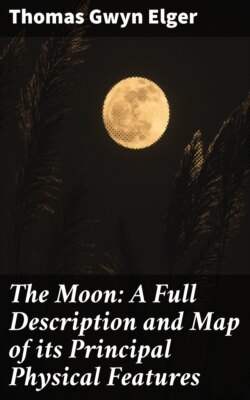The Moon: A Full Description and Map of its Principal Physical Features

Реклама. ООО «ЛитРес», ИНН: 7719571260.
Оглавление
Thomas Gwyn Elger. The Moon: A Full Description and Map of its Principal Physical Features
The Moon: A Full Description and Map of its Principal Physical Features
Table of Contents
PREFACE
THOMAS GYWN ELGER. BEDFORD, 1895. INTRODUCTION
CATALOGUE OF LUNAR FORMATIONS. FIRST QUADRANT
SECOND QUADRANT
THIRD QUADRANT
FOURTH QUADRANT
APPENDIX. DESCRIPTION OF THE MAP
FIRST QUADRANT
SECOND QUADRANT
THIRD QUADRANT
FOURTH QUADRANT
LIST OF SOME OF THE MOST PROMINENT MOUNTAIN RANGES, PROMONTORIES, ISOLATED MOUNTAINS, AND REMARKABLE HILLS. FIRST QUADRANT
SECOND QUADRANT
THIRD QUADRANT
FOURTH QUADRANT
LIST OF THE PRINCIPAL RAY-SYSTEMS, LIGHT-SURROUNDED CRATERS, AND LIGHT- SPOTS
FIRST QUADRANT
SECOND QUADRANT
THIRD QUADRANT
FOURTH QUADRANT
POSITION OF THE LUNAR TERMINATOR
LUNAR ELEMENTS
Volume (earth's = 1) - ¼9.20 or 0.02033
Отрывок из книги
Thomas Gwyn Elger
Published by Good Press, 2019
.....
Neison and some other selenographers place in a distinct class certain of the smaller ring-plains which usually have a steeper outer slope, and are supposed to present clearer indications of a volcanic origin than the ring-plains, terming them "Crater-plains."
CRATERS.—Under this generic name is placed a vast number of formations exhibiting a great difference in size and outward characteristics, though generally (under moderate magnification) of a circular or sub-circular shape. Their diameter varies from 15 miles or more to 3, and even less, and their flanks rise much more steeply to the summit, which is seldom very lofty, than those of the ring-plains, and fall more gradually to the floor. There is no portion of the moon in which they do not abound, whether it be on the ramparts, floors, and outer slopes of walled and ring plains, the summits and escarpments of mountain ranges, amid the intricacies of the highlands, or on the grey surface of the Maria. In many instances they have a brighter and newer aspect than the larger formations, often being the most brilliant points on their walls, when they are found in this position. Very frequently too they are not only very bright themselves, but stand on bright areas, whose borders are generally concentric with them, which shine with a glistening lustre, and form a kind of halo of light around them. Euclides and Bessarion A, and the craters east of Landsberg, are especially interesting examples. It seems not improbable that these areas may represent deposits formed by some kind of matter ejected from the craters, but whether of ancient or modern date, it is, of course, impossible to determine. Future observers will perhaps be in a better position to decide the question without cavil, if such eruptions should again take place. Like the larger enclosures, these smaller objects frequently encroach upon each other—crater-ring overlapping crater-ring, as in the case of Thebit, where a large crater, which has interfered with the continuity of the east wall, has, in its turn, been disturbed by a smaller crater on its own east wall. The craters in many cases, possibly in the majority if we could detect them, have central mountains, some of them being excellent tests for telescopic definition—as, for example, the central peaks of Hortensius, Bessarion, and that of the small crater just mentioned on the east wall of Thebit A. A tendency to a linear arrangement is often displayed, especially among the smaller class, as is also their occurrence in pairs.
.....